“The Thirteenth Hat” / “Batman Stands Pat”
Written by Charles Hoffman
Directed by Norman Foster
Season 1, Episodes 13 and 14
Production code 8719
Original air dates: February 23 and 24, 1966
The Bat-signal: A chef reports for work in a very low-rent kitchen, when the Mad Hatter and two of his goons burst in on him. He steals the chef’s hat—thanks to the Lenny Henry show Chef! I will always think of a chef’s hat as a “culinary condom“—and then uses the super-instant mesmerizer in his big-ass top hat to render the chef unconscious. He does the same to a man wearing a deerstalker on a street corner, and the manager of a silver shop.
Gordon and O’Hara muse on these hat-related crimes, which he really and truly says are happening “right under our noses,” making me wish O’Hara said, “Well, technically, sir, they’re happening over our noses ’cause that’s where you’ll be wearin’ a hat,” but he didn’t, and I was sad. Strangely, Gordon’s main concern seems to be for the hats, even though the Hatter is also kidnapping people…
Anyhow, Jervis Tetch, a.k.a. the Mad Hatter, has been released on parole, and is immediately going after people and their hats. Gordon, of course, calls Batman. This handily gets Bruce and Dick out of the Gotham City Society Tea Tasting, where Aunt Harriet is struggling with whether or not to lead with oolong or pekoe. While Bruce is apparently an expert in Italian marble sculpture, he knows diddly about tea, and gives Harriet no useful advice.
They bop off to GCPD HQ, where we are told that the Hatter threatened Batman with revenge after the Cowled Crusader (Gordon calls him that instead of “Caped,” as this is a Mad Hatter episode, and therefore his cowl is more important than his cape this time ’round) testified against him in court. How someone who refuses to reveal his real name on the record can possibly testify in a court of law is left as an exercise for the viewer. (Seriously, how does that work? “State your name for the record, please.” “I’m Batman.” “First or last name?”)
Gordon gets a call saying that the fire chief, and his shiny red hat, have been taken. Batman and Robin head out, and O’Hara says to clear all exits for the Batmobile. Why this is necessary when the Batmobile is parked on the street is also left as an exercise for the viewer.
The Hatter has placed hats on dummies that represent the twelve jurors at his trial. He has eleven of them, with two more to go—the twelfth juror, but also Batman’s cowl. His moll, Lisa, admires the notion, but his two thugs are wondering when they’ll get paid. The Hatter then shows off the death trap in his hat factory—all stuff used to make hats, but which will kill a person, like, say, Batman.
He then reveals that the people he’s kidnapped are the actual jurors in his trial. He plans to ransom them for all the president’s hats, currently on display at a local museum, and worth millions.
Batman and Robin question the hat-check girl, Babette, at the event where the fire chief was kidnapped. They then follow up on a sighting of the Hatter at Maison Magda, a hat shop where Lisa works as saleswoman. However, they arrive too late to keep the Hatter from kidnapping Madam Magda, who was also on the jury.
Lisa hands Batman a business card that the kidnapper “dropped.” They take it back to the Batcave. It has the name of a sculptor, Octave Marbot, who is making a statue of Batman to put in the prison to inspire the prisoners. Robin says that’s a great idea, which is the opposite of what’s true. (Seriously, all that’ll do is remind the prisoners why they’re there…) They determine that the pattern of places where the people were kidnapped, as well as Marbot’s studio make the shape of a top-hat on a Gotham City map.
The Hatter goes to Marbot’s studio, hits him with the mesmerizer, and then takes his place, wearing his beret and smock and a very obviously fake beard. Batman and Robin arrive, and the Hatter greets them posing as Marbot with the worst French accent in the history of humanity.
“Marbot” then asks if Batman would take the time for a sitting, but Batman doesn’t have time. He does agree to loan “Marbot” his cowl so he can adjust the head. They go into the dressing room, ostensibly for him to remove the cowl in private and Robin can bring it out to the sculptor. However, Batman saw through the ruse, not because he’s met Marbot and Tetch looks and sounds nothing like him, but because the real Marbot was quite happy with the head of the statue and wouldn’t need to adjust it. Right. Once they determine that the real Marbot is safe, fisticuffs ensue. Batman and Robin take down the Hatter’s thugs, but when the Hatter tries to use his mesmerizer on Batman, he uses a mirror to reflect it away—
—but right at Robin! The Boy Wonder falls to the floor, and Batman’s so devastated that the Hatter easily throws him into the wall right under the hardening plaster dispenser, which drenches Batman in wet plaster that is hardening fast.
The Hatter forces Marbot to cut away the head of the newly formed Bat statue so he can have a mold of the cowl. He’s tied Robin to a marble horse and sends one thug out to steal the Batmobile. However, Batman—who apparently can hold his breath for as long as it takes to tie up Robin and chip away at a statue—just held his breath and then broke out when Marbot’s chipping weakened the plaster enough for Batman to physically break through.
The Hatter and his thugs try to get away in the Batmobile, but the same anti-theft device that got the Riddler gets them, and they run away on foot instead. They get away by virtue of Batman taking the time to dust himself off and offer to help Marbot clean up his shop.
They return to the Batcave. The Hatter mentioned the cowl as being his thirteenth hat. It turns out six other people have been reported to be kidnapped along with their headgear. Batman and Robin speculate as to what comes in twelves, but there are too many possible answers, so they consult the computer. Eventually, they figure out that the Hatter is taking the jurors at his trial.
Gordon fetches the list of jurors, and the last name is Turkey Bowinkle. Yes, really. Batman sends Alfred to Bowinkle’s Bowling Alley in order to slip a tracer on his hat. Alfred poses as a genealogist, contriving a ridiculous excuse to look at his hat, but Bowinkle—who’s not the sharpest knife in the drawer—won’t let him see it. Lisa then arrives, distracting Bowinkle with her hotness. Alfred, realizing he no longer has a captive audience, pays for his drink and leaves, using Lisa’s distraction to check out Bowinkle’s office and put the tracer on the hat.
Lisa, of course, is there for the Hatter, claiming to be a reporter for a fashion magazine that has listed him as the best-hatted man in Gotham. He tells her it’s in the office, and she signals the Hatter, who arrives in Bowinkle’s office right after Alfred has placed the tracer in the bowler’s bowler. The Hatter takes the hat and confronts Bowinkle. They struggle briefly for the bowler, which reveals the tracer, and then the Hatter mesmerizes Bowinkle, taking him away.
The Hatter leaves the tracer on the bowler in the hopes of trapping Batman, and it works. The Dynamic Duo climb the wall and burst through the window, but the Hatter and the thugs get the drop on them. They’re led at gunpoint to the hat factory, but Batman manages to use a nearby scarf to get the drop right back on them, and fisticuffs ensue. At one point, Robin is knocked out, and put on the conveyer belt of the hat factory—yet he goes through the rabbit shearer and the blades without being hurt before Batman frees him. In the end, Batman kicks the Hatter into the acid cleaner, from which he emerges completely unscathed, but somewhat dazed.
Later, Bruce and Dick take Harriet to Madam Magda’s to buy her a hat for her birthday, probably by way of making up for being kidnapped and losing her saleswoman to prison.
Fetch the Bat-shark-repellant! It’s the triumphant return of the Giant Lighted Lucite Map of Gotham City! I love the Giant Lighted Lucite Map of Gotham City! The Giant Lighted Lucite Map of Gotham City is the best! We also have the Anti-Mesmerizing Bat Reflector (which is, basically, a mirror) and a Bat-tracer, which they follow with the Detect-a-Scope in the Batmobile. At one point, we get a look at the International Frequency Computer, which they don’t use, but there’s the Anti-Crime Computer, which leads them to figure out that the jury’s been kidnapped.
Holy #@!%$, Batman! When the fire chief is kidnapped, Robin cries, “Holy helmets!” He says “Holy switcheroo” when he realizes that the Hatter has disguised himself as Marbot. Just as he falls to the reflected mesmerizer, he mutters, “Holy ricochet.” At the revelation that Batman held his breath, a stunned Robin cries, “Holy frog-man!” while the later revelation that the Hatter found the tracer in Bowinkle’s hat prompts a “Holy bowler!”
Gotham City’s finest. Gordon acquires the list of jurors in the Hatter’s trial. He’s staring right at it, yet he has no idea why Batman would want it, even though eleven of the twelve names on it are the same as the eleven people who’ve been kidnapped. Dumbass.
No sex, please, we’re superheroes. Lisa is completely smitten with the Hatter, to the point of fawning, and Babette the hat-check girl and Hermione Monteagle are equally smitten with Batman, who remains utterly oblivious to their drooling.
Special Guest Villain. David Wayne debuts the Mad Hatter. He’ll return to the role in season 2’s “The Contaminated Cowl” / “The Mad Hatter Runs Afowl,” also written by Charles Hoffman.
Na-na na-na na-na na-na na. “I’m a practical man.”
The Mad Hatter’s line shortly before he discusses his plan to ransom twelve people for a hat collection.
Trivial matters: This episode was discussed on The Batcave Podcast episode 7 by host John S. Drew with special guest chum, Linda-Ali Cruz.
For the first time, both the voiceover and the text use “Same Bat-time, same Bat-channel!” for the cliffhanger.
This episode borrowed bits from several comic book appearances of the Mad Hatter: Detective Comics #230 by Bill Finger & Sheldon Moldoff, Batman #161 by Dave Wood & Moldoff, and Batman #49 by Finger.
The Mad Hatter who appears in this episode is based on the second villain to call himself that, who first appeared in the aforementioned Detective #230 in 1956—he even used the same name as the original Hatter (who first appeared in Batman #49 in 1948). Later (some fifteen years after this episode aired), it was revealed that the second Tetch was an impostor and the original took the moniker back. The second Hatter recently appeared as “Hatman” in Batman #700.
Diane McBain, who plays Lisa, will return in the Green Hornet crossover episodes “A Piece of the Action”/”Batman’s Satisfaction” as Pinky Pinkston.
Pow! Biff! Zowie! “How could I have been so stupid?” Aspects of this episode work rather well. David Wayne is obviously having a grand old time as the Hatter—or, rather, Jervis Tetch. This is the second code-named villain whose real name is also revealed, but unlike Mr. Freeze (a.k.a. Dr. Art Schivel) whose name is only mentioned once or twice, this one is used as often as the Lewis Carroll-inspired sobriquet, probably because “Jervis Tetch” is fun to say out loud.
Anyhow, Wayne is fun, and I really like Diane McBain’s performance as Lisa. Unlike all the previous molls who were either bored young women in it for kicks or good women led astray by the lure of evil, Lisa is a total sociopath. She takes absolute glee in observing how the hat factory deathtrap works, and just in general is an eager participant in the Hatter’s schemes. (More so than the two thugs, who are mostly peeved that they haven’t gotten paid. Then again, Lisa actually has a day job…)
Unfortunately, the storyline has lots of nonsensical stuff, even by this show’s high standards. It starts with the emphasis on hats being stolen, with the actual people being kidnapped as an afterthought. At the start when Gordon gets the report, all the way through to later when Batman calls Gordon for an update, everyone’s emphasizing the haberdashery and not the kidnapping. Hell, in most cases, you probably can’t even tell the hats were also taken (viz. the chef, who was wearing the thing when he was taken). The general lack of concern for people is kind of appalling.
So is the policework. At least Batman is kind enough to admit to being stupid when he finally cottons to what the kidnap victims all have in common, but Gordon doesn’t figure it out when he’s staring at a list of the jurors.
And finally, we get a truly awesome deathtrap—and it’s not the cliffhanger! And when it is used, it doesn’t work! Seriously, Robin lays on it and then is not skinned or sliced, even though he goes right through those two parts of the deathtrap. Lame.
Bat-rating: 6
Keith R.A. DeCandido‘s latest work is an essay that lists the top ten good things about the Star Wars prequel trilogy in A Long Time Ago: Exploring the Star Wars Cinematic Universe, just released by Sequart. Yes, he actually found ten.










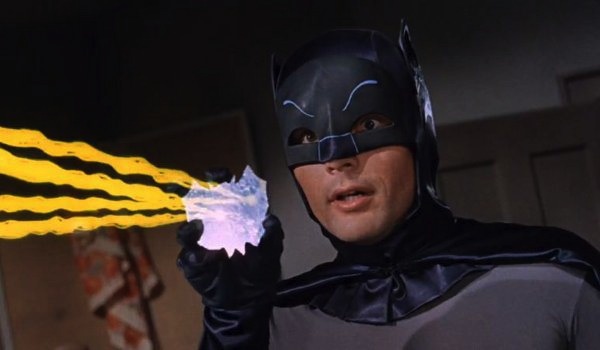
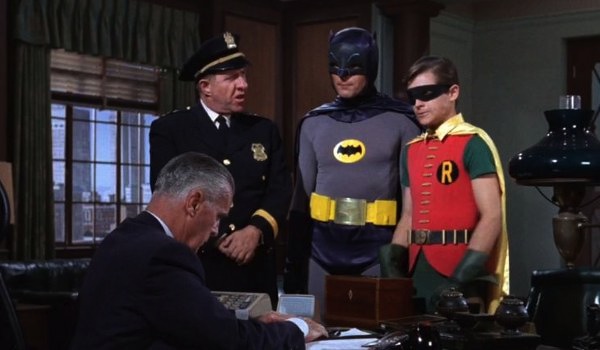
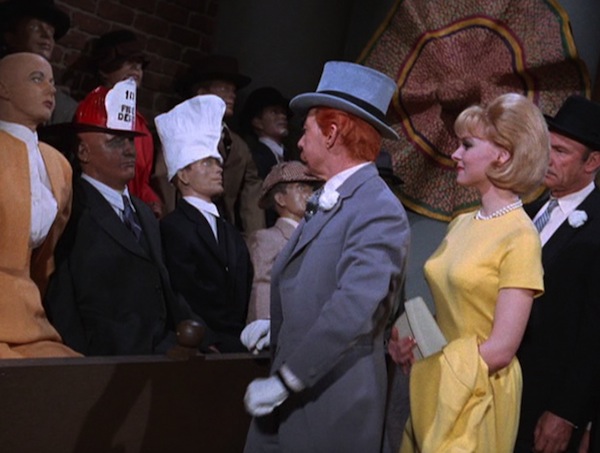
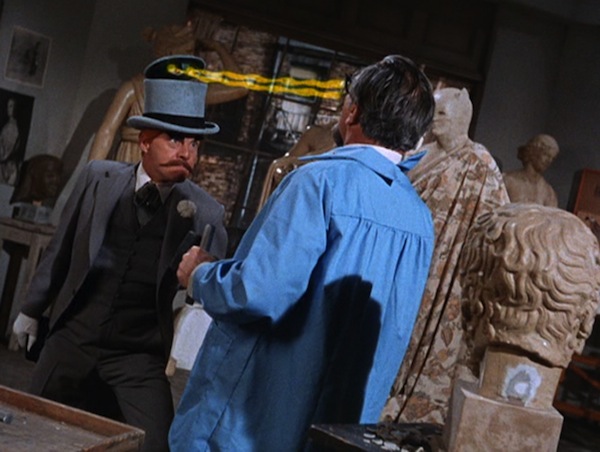


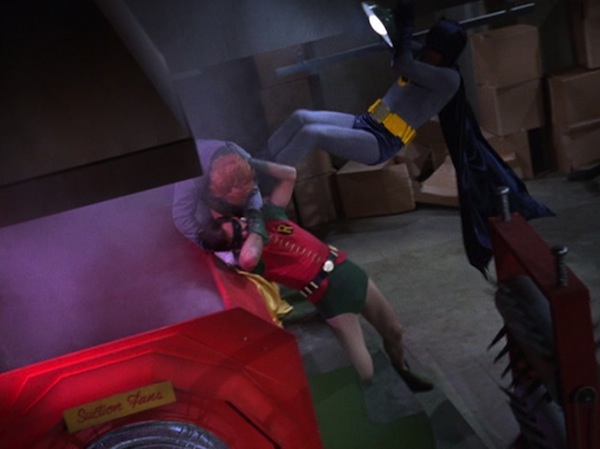
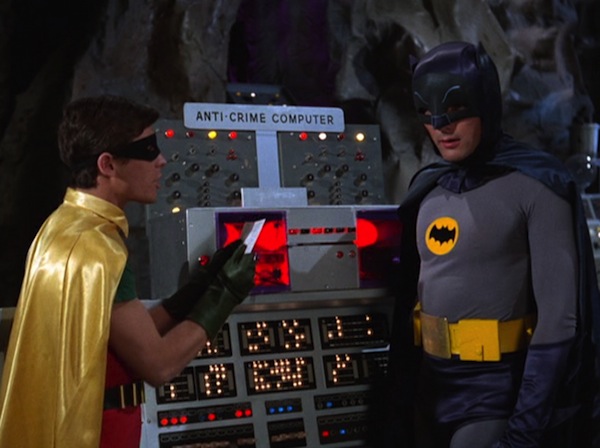
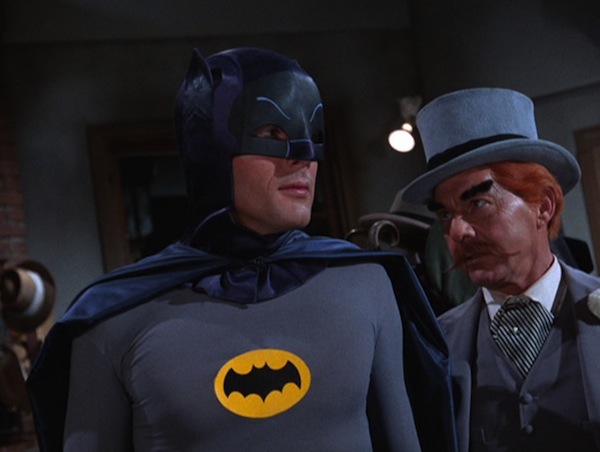

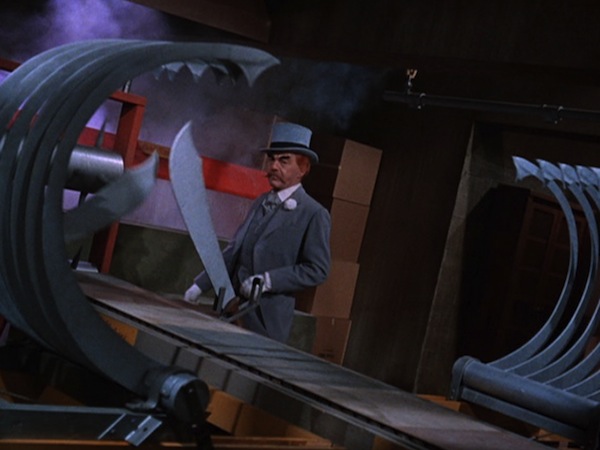
I’ve always thought this was one of the comics’ weaker villains. Maybe it’s because hats were definitely out by the time I was reading and really were pretty much out by the time this aired. They could have at least given him a tea obsession to go along with his hat mania. Bob Kane seems to have had a thing for Alice in Wonderland, since Tetch was his second Alice-themed villain after the Tweedles.
Still, David Wayne is clearly having fun and that helps a lot. Actually most of the villains seem to be having a lot of fun, which brings a lot to what could otherwise be a tediously silly show.
Alas, the combination of someone named Bowinkle and hats leaves me forever hearing Rocket J. Squirrel saying, “Again? That trick never works.” Which I suppose is appropriate in a way.
I honestly thought it was “Bullwinkle” until I read the closing credits and saw it was “Bowinkle.” Thank heavens for search-and-replace. (I similarly thought Marbot was “Marbeau,” and had to correct upon viewing the credits………)
—Keith R.A. DeCandido
Re: the death trap. You are right, this was the greatest death trap ever to see, and it was a disappointment (in terms of excitement, not in terms of “nobody died”) when it was used. I felt genuinely tense when Robin was thrown on it, and felt complete disappointment when I saw him slip past the “skinner” without it touching him. The whole fight lost its tension there and then. And the icing was when the Mad Hatter went into the acid (I remember thinking “Nice, an origin story. Was Jack Nickelson’s Joker a hommage?”) and he just sputtered out.
What I really liked about this episode was that Alfred was used as a spy, and he was absolutely GREAT at it. Just look at him, using schemes to get what he wants, posing as a genaeologist, changing tactics when he figures one way doesn’t work, cutting his losses when Lisa arrives, hiding his 6ft+ body behind stacks, sneaking his 6ft+ body up and down stairs, slipping away. The only reason he fails is because Bowinkle was just plain dumb. Alfred deserved better. He needs our recognition for this. And I want more Spying Alfred.
Anybody here who truely believes Mad Hatter would’ve sold the collection of President’s Hats? Even in need of cash he would’ve held on to it. And in the name of all that is good, who will he sell it too? The only collector mad enough about hats to buy these “hot” hats, would be… he himself?
(Getting rid of the loot is a problem coming up more in this series. Case in point: last week’s famous diamonds.)
The “clear all exits for the Batmobile” line could be taken to mean that the police are being instructed to clear traffic from all exit routes away from police HQ. Or, hey, maybe after Batman and Robin run into the building, the Bat Valet Parking Service arrives and drives the Batmobile around to the garage.
And we all love the Giant Lighted Lucite Map of Gotham City. I’m disappointed that later on, they seemed to depend more on the Batcomputer to give them locations than on the GLLMoGC.
Most of the absurdities you complain about were probably intentional comedy, like the cops caring more about the stolen hats than the people abducted with them. I can imagine something like Rocky & Bullwinkle (fittingly) using a similar conceit. Although Batman, Robin, and the police having so much trouble realizing that the jurors are being abducted does come off as rather lame. If it was intended as a joke, it didn’t come off very well.
And there just happens to be an exhibit of famous presidential hats for Tetch to covet? You’d think that Gotham’s museums would eventually learn never to hold any exhibits pertaining to things like hats, jokes, riddles, cats, umbrellas, or Ancient Egypt.
You mention Mr. Freeze being given a real name (although it was just Dr. Schivel — the “Art” probably comes from the recent Batman ’66 comics), but both of the character’s names were coined for the series; in the comics, he was a one-shot villain named Mister Zero. There’s also Eivol Ekdal, but he didn’t have a nom de crime. So Mad Hatter/Tetch is the first and only time than an established comics villain is referred to in the show by his established real name from the comics as well as his villain nickname. The other six comics villains who appear in the show — Joker, Riddler, Penguin, Catwoman, False-Face, and Clock King — are never given any other names. (Clock King is identified in the recent comics as Jervis Tetch’s brother Morrie, as I recall, but that was never asserted in the show itself.) As for the original villains, hardly any of them were given both a nickname and a real name. There’s Siren/Lorelei Circe in season 3, but Circe might be an alias. And there’s Lola Lasagne/Lulu Schultz, but neither of those is a villain name per se. (Some of them have been given names in the recent comics, including King Tut.)
Anyway, we’re still getting that thing where characters are using “Boy Wonder” as if it were Robin’s actual superhero name. That’s strange.
Also kind of surprising to be shown a really elaborate deathtrap in the first half and then have the cliffhanger revolve around a spur-of-the-moment peril. And man, that Lisa is a hardcore moll, really excited by Tetch’s descriptions of the ghastly things his machine would do to human flesh. That was a creepy scene.
@3/Artsapat: The acid-bath origin story for the Joker comes not from the ’89 movie, but from Detective Comics #168 in February 1951, in the story “The Man Behind the Red Hood” by writer Bill Finger, pencilers Lew Sayre Schwartz and Win Mortimer, and inker George Roussos.
And Alfred is great at everything (well, except maybe painting). Don’t worry, you will get to see more of Alfred’s undercover endeavours in the weeks ahead.
“How someone who refuses to reveal his real name on the record can possibly testify in a court of law is left as an exercise for the viewer. (Seriously, how does that work? “State your name for the record, please.” “I’m Batman.” “First or last name?”)”
This article actually goes into the legal issue there, it’s fairly interesting. The problem isn’t really not being able to offer your real name on the record (though that is kind of tangentially related), but rather that testifying in a mask or other physical means of concealing your identity would likely violate the confrontation clause of the US Constitution. (It’s been established by legal precedent that even something as simple as a physical screen between the one testifying and the defendant are in violation of the confrontation clause, so a mask almost certainly would be.)
Though the DC comics side got around it with a fictional “Twelfth Amendment” at least.
This is a Silver Age fantasy world. Batman is able to do all sorts of things in costume and under the name Batman — serve as a duly deputized officer of the law, testify in court, run for mayor, you name it. That’s part of the extended joke, because it’s the way a lot of the comics of the day did it — Batman and Robin were almost always Batman and Robin, even in situations where it would make more sense to be Bruce and Dick. That’s why the show never had them take their masks off or call each other Bruce and Dick when they were in the Batcave.
The animated series Batman: The Brave and the Bold was in a very similar vein to this show — although it was an unapologetic celebration of the same Silver Age era that Batman ’66 was essentially ridiculing. In that show, Batman was practically always Batman. We saw the odd flashback where his younger self was addressed as Bruce by his parents, but it wasn’t until more than halfway through the series that we actually saw the adult Bruce Wayne’s face. (Which made for a really powerful moment when he did unmask at last.)
Thinking about Alfred, it’s interesting that he was in the show at all. When it first aired, he was officially dead in the comic continuity and had been for a couple of years. He had been replaced by Aunt Harriet. He was resurrected and turned into a supervillain (the Outsider) in October of ’66. I haven’t been able to find out just when he was turned back into normal Alfred, but the Outsider seems to have had a bit of a run. I wonder if the show had anything to do with his return in the comics.
@7/DemetriosX: According to this article, it was indeed Alfred’s presence on the show that led the comics to bring him back to life, just as it was the ’43 serial’s decision to cast a tall, thin actor as Alfred that led them to change his original short, fat appearance. As for why the show included Alfred when he was dead in the comics, it doesn’t say. But I’d guess it’s because the TV series was largely inspired by the recent re-release of the ’43 serial and the way ’60s audiences reacted to it as campy comedy. While the show was, in many ways, very faithful to the Silver Age comics, it also drew on the serial in its use of cliffhangers, so maybe it was emulating the serial by including Alfred.
Or maybe it’s just because some of the stories they read in researching the show (including the ones that some of the first half-dozen episodes are based on) were reprints of stories from the ’50s or early ’60s, when Alfred was still around.
@8 CLB: That was an interesting article. From his description it sounds like Alfred came back in October 66, while what I had before sounded like the Outsider first appeared then. Although as I think about it, it seems as though the Outsider was finally revealed and defeated in that issue.
It looks as though, unlike Alfred, Aunt Harriet didn’t morph in the comics to reflect her film personality. But from what I can find, they did make her look more like Madge Blake when they brought her back for the New 52 and for the Batman 66 comics. I’ve also realized that in my head Madge Blake and Frances Bavier (Aunt Bee from Andy Griffith) have merged into one person.
@9/DemetriosX: From what I’ve seen of Madge Blake elsewhere, it seems they tailored Aunt Harriet to fit her personality. (I haven’t seen her in many other things, though. The most recent one was an episode of The Man from U.N.C.L.E. where she played a bit role as an agent of the title organization. I loved that — The Aunt from U.N.C.L.E.!)
@10 CLB: She certainly seems to have been all over television in the late 50s and 60s. She was usually a one-shot, though she did have a few recurring roles, but not in anything I’ve ever seen or at least remember (except her appearance on The Addams Family). She died just a couple of years after Batman was canceled, so there isn’t a whole lot of newer material for her to have been in. But making Aunt Harriet a total ditz does seem to fit the sort of roles she played. That is a pretty big departure from Aunt Harriet in the comics, she was pretty sharp.
Actually, looking at everybody’s credits, except for the villains, who were all stars, the show seems to have been a real career killer. Alfred, the Commissioner, the Chief, very few roles afterward as compared to what they were doing before. Burt Ward had never really acted before and mostly went back to real estate outside of opportunities to play Robin (he voices Robin in Arkham Knight!). And as for Adam West, the roles where he isn’t playing a version of himself, Batman, or they’ve cast him in something Batman-related as an Easter Egg are few and far between.
@11/DemetriosX: Yeah,the actors became so indelibly associated with the show that the typecasting pretty much killed their careers. Which is a shame, because most of them were really good actors. West could’ve made an excellent dramatic/romantic lead, and that’s where his career was headed before Batman.
Of course, both Alan Napier and Neil Hamilton had illustrious careers already before Batman. A much younger Hamilton was the rival for Jane’s affections in the first two Johnny Weissmuller Tarzan movies — which are a bit disturbing to watch because of their deep, casual racism, with Hamilton’s character brutally whipping the African bearers even though he’s portrayed as a heroic figure. (And is supposed to be compassionate toward them. When a bearer falls off a mountain in the first movie, Hamilton’s character at least offers a “Poor devil” while everyone else is only concerned with the lost supplies.)
Krad, you can’t complain about the emphasis on hats, this is a comedy, and an absurd one at times, that’s being played for laughs.
@3 Artsapat: +1 on the Spying Alfred remarks.
@@.-@ – Chris: No, Gotham must continue to host exhibits on whatever it wants. Stopping would be giving in to the criminals!
As for King Tut’s name, it’s odd that they didn’t give King Tut a real name, given that his origin as an egyptologist gone mad is mentioned. One would think they’d mention his real name.
@13/lordmagnusen: Well, I don’t think the comics at the time were all that big on referencing villains’ real names, even when they had them. And not just villains. The reason Alfred was never given a last name in the show is because his last name wasn’t definitively established as Pennyworth until 1969, shortly after the show ended. Before that, he’d occasionally been called Alfred Beagle or Alfred Jarvis (yes, Jarvis), but had usually just been Alfred.
Then again, the show never mentioned Commissioner Gordon’s or Chief O’Hara’s first names either. It was just part of the show’s style. The Mad Hatter is one of the few exceptions to the pattern of giving a character only one name. I mentioned a couple of others above, but there was also Liberace’s character Chandell (also nicknamed Fingers) and arguably Tallulah Bankhead’s Black Widow (“Mrs. Max Black, widow”). Another is in the rather lame second-season finale, which MeTV just reran this weekend, in which Batman gets inexplicably and unfunnily obsessed with pointing out at every opportunity that Mr. Freeze’s henchwoman Glacia Glaze was born under the name Emma Strunk.
Yeah, but my point was that King Tut actually had a civilian identity that was a honest, contributing to society, person. All of the others I can remember are just criminals, probably with the exception of Zelda or Chandell (he was a publicly performing musician, wasn’t he?).
@15: Sure, but as I pointed out, not all the civilians got full names either.
You mean Gordon’s first name is not Commissioner?
DC doesn’t seem to have been all that into real names for their villains, especially in the Silver Age. Joker has never had one and I think the Cobblepot name for the Penguin also came much later. The Riddler and Catwoman both had civilian names, but his was mostly a joke to reinforce the whole riddle theme and Selina Kyle was largely forgotten once she went from the Cat to Catwoman. Tetch was established in comics continuity, like Nigma and Kyle, but I don’t know about, say, the Tweedles. So many other Batman villains tended to one-offs or only rarely recurring. Even Two-Face only appeared 3 times before 1971.
Obviously, post-Frank Miller, Batman is a surname. Full name: The Goddamn Batman.
@18/DemetriosX: The Penguin’s full name was revealed in the Batman newspaper comics in 1946. And “the Cat” was occasionally called the Cat-Woman by her second story in 1940, and became known exclusively as the Catwoman not long thereafter, but she wasn’t established as Selina Kyle until 1950, in a story that revealed she’d been an amnesiac and had forgotten her true identity, but wanted to go straight once she remembered who she was (which was the beginning of her ambiguous good-bad characterization that’s purr-sisted ever since).
@19 CLB: I thought Selina Kyle was established in her first appearance. There was supposed to be some sexual tension between her and Batman right from the beginning, so they would eventually have had to go with her walking the line between good and evil fairly quickly, or he’d never have been tempted.
Do you know when the Cobblepot name first made it to the books? I should have known the name was fairly early, since it’s so utterly ridiculous.
So does this leave Joker as the only bat-villain without a real name?
@20/DemetriosX: I’m looking through “the Cat”‘s debut story now, and I’d say there was the same amount of “sexual tension” that any male hero of the day would’ve had with any femme fatale. For most of the story, she was disguised as an elderly lady, until Batman unmasked her, responding to her resistance by saying “Quiet or Papa spank,” which was what passed for witty sexual banter back then. Once she’s caught, she behaves like any villainess would in a story of the day — she offers no physical resistance, but then starts flirting with Batman and invites him to join her as her partner, saying they could become “King and Queen of Crime.” Uncharacteristically, Batman says, “Sorry, your proposition tempts me, but we work on different sides of the law.” Then Batman and Robin take her away, but when she makes a break for it, Batman fouls up Robin’s attempt to stop her, and Robin wonders if he did so on purpose. Batman denies it, but spends the last couple of panels mooning over her like a schoolboy and hoping he runs into her again, while idly and ineffectually reminding himself that he’s dating a girl named Julie (Madison, Bruce Wayne’s first love interest). There’s not a hint of moral ambiguity in her; Batman is tempted purely because she’s a hot dame and he’s apparently a 12-year-old. Keep in mind that this was from Batman #1, when the character was only a year old and still not far removed from his pulp-vigilante beginnings.
But she’s given no real name. “The Cat” is her revealed identity beneath her old-lady disguise, and she gets away before any further investigation of her identity can be undertaken. As the 1950 story revealed, Catwoman was the identity that stewardess Selina Kyle adopted after a plane crash caused her amnesia. Rather randomly, her cat obsession was justified with the throwaway explanation that her father once owned a pet shop.
As for the Penguin’s real name, that article I linked above says that it was “quickly ported over” to the comics, so presumably that was during 1946.
I’d say the Joker is, yes, pretty much the only perennially nameless villain in Batman’s rogues’ gallery, although I don’t think Ra’s al Ghul’s birth name has ever been revealed.
#14: Of course in Chandell’s case, there’s Evil Twin Harry to consider (one has to wonder, in the circumstances, whether “Chandell” was the pianist’s original first or last name; if the latter, that would make Harry “Harry Chandell”). And we got a handful of full-named villains in Season 3 — the Ffoggs, Nora Clavicle, Dr. Cassandra Spellcraft.
Poking around, it looks like King Tut does have a civilian name on the show: William McElroy. Quite a few of the others do, too. Egghead, Bookworm and a few others. But the really big villains do without: Joker, Catwoman, Penguin, Riddler.
Demetrios, but was that name given in the show, or is it from later comics?
@24 lordmagnusen: Seems to be from the show. He didn’t appear in the comics until 2007 or 2009, where he is Victor Goodman. I guess we’ll find out for sure in a couple of months.
No, I wasn’t referring to the Goodman version, but to the same character as in the show, in the Batman ’66 comics. But still, Chris seems so certain that he’s never named as such in the show, that it seemed weird to me that a character who’s not a career criminal, but a respected scientist, is not given a name.
@23/DemetriosX: I checked my Official Batman Bat-Book, a series reference guide published in the ’80s, and it confirms that Tut’s real name was given in his very last appearance in the series, “I’ll Be a Mummy’s Uncle” in season 3. His full name was given in the book as William Omaha Mackelroy.
As for the others, though, the references you’ve been consulting are wrong. Those characters were not given names in the show itself, but only in the recently ended Batman ’66 comic book, set in the universe of the show. The problem is that online references are blending the show and comic versions together and giving the false impression that the names coined by the comic in the past couple of years were used in the show nearly half a century ago. I really wish they’d be clear about the distinction.
Well, that explains some of the contradictions I’ve found and why it’s sometimes difficult to pin down a clear answer. It does seem odd that it took them so long to give King Tut a real name since part of his shtick is that getting hit on the head switches him between personalities.
Yeah, that was my point… but you know they could get away with just calling him “Professor”…
@28/DemetriosX: And as I’ve been saying, it’s not that odd that they didn’t give Tut a civilian name when you consider that giving villains civilian names was the exception to the rule. As a matter of “house style,” real names were avoided. Occasional exceptions did happen, but it was never something to be expected.
I mean, look at all the times that Penguin or Catwoman seemed to be going straight and giving up their lives of crime. They never went by their civilian names even in their supposedly respectable occupations. Penguin even ran for mayor under the name Penguin. So while it may have been implicitly obvious that Tut would’ve used a different name as a mild-mannered professor from Yale University, it was in keeping with the show’s usual style to avoid mentioning the name. It may have been odd to do so, but it was deliberately odd, part of the show’s exaggerated send-up of the conventions of the comics of the day, in which villains’ real names were infrequently used.
Penguin ran for mayor as Penguin, and Batman ran for mayor as Batman. I love that episode.
@31/lordmagnusen: What’s amazing about the mayoral-race episode is how it still works as a sendup of political campaigns today. Nothing has really changed, has it?
It really hasn’t, no.
On the other hand, I have a specific childhood memory of watching the episode in my parents’ room, eating my mom’s homemade pancakes. Thus, I always crave pancakes when I think of it.
Maybe I just can’t get my head completely into the very odd space that this show occupies. I seem to be fine with the sheer idiocy of the police, Batman wandering around and doing utterly mundane things in costume, Batman being a sort of über-Boy Scout, and so much more, but I stumble over this name thing. Ah, well. I’m still enjoying this rewatch immensely.
@34/DemetriosX: Here’s perhaps the ur-example of “Batman wandering around doing utterly mundane things in costume,” from The Brave and the Bold #102 by Bob Haney (who could always be counted on for absurdity) and Jim Aparo:
http://markwaid.com/greatmomentsincomics/great-moments-in-comics-27/
@35 CLB: That’s pretty good, although it’s the narration box that really makes it. It isn’t quite on par with Batman going in to the night club in the first episode or wandering into shops and trying to act like a regular customer, but just walking down the street enjoying the fine spring weather and all the miniskirts is pretty close.
I wonder if he and Robin ever took the Batmobile to a drive-through or one of those drive-up restaurants where the carhops came out on roller skates.
@36/DemetriosX: Yes, in “The Clock King’s Crazy Crimes” in season 2. I believe the carhop does have roller skates.